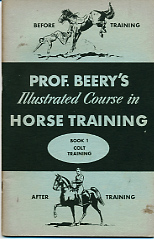 I came across a cache of “Prof. Beery’s Illustrated Course in Horse Training” booklets recently, along with a set of “Home Course in Animal Breeding.” Both were published by the Beery School of Horsemanship, Pleasant Hill, Ohio, with an original copyright of 1908. I ordered my editions in the late 1950s, through a classified ad in Western Horseman magazine.
I came across a cache of “Prof. Beery’s Illustrated Course in Horse Training” booklets recently, along with a set of “Home Course in Animal Breeding.” Both were published by the Beery School of Horsemanship, Pleasant Hill, Ohio, with an original copyright of 1908. I ordered my editions in the late 1950s, through a classified ad in Western Horseman magazine.
Born in 1861, Jesse Beery was a forerunner of today’s equine “clinicians.” At a time when rural and small-town USA depended on horsepower for work and transportation, he parlayed his gift for handling horses into a successful traveling exhibition where he demonstrated his methods for controlling unruly animals and curing their bad habits.
In 1905, following the death of his father, who had been a prosperous farmer, Beery returned home to Pleasant Hill, where he founded his school of horsemanship, and developed an expansive line of patented training devices, as well as his famous correspondence course. He died in 1945.
The first volume of the eight-volume course is titled “Colt Training” and the last is “Teaching Tricks to Horses and Dogs.” The remaining six volumes are all devoted to breaking bad habits created by poor training. It should come as no surprise that the bad habits, with the exception of trailer loading, are the same ones that bring horse owners to modern clinics.
Beery makes the point in the introduction to “Colt Training” that “among the animals of equal or greater strength, the horse is the most useful to man because of its superior nervous development, by which it … gives instant response to any outside stimulus.”
That “instant response” is, of course, the “Catch 22” of horse handling, giving thoughtful, intelligent trainers a definite advantage and those that aren’t (thoughtful and/or intelligent) a barn full of horses in need of volumes two through seven, which cover kicking, balking, bolting, shying and a host of other vices.
“The horse is superior to man in muscular strength and often in the sense of seeing, hearing and smelling,” Beery acknowledges. “Man, however, has the advantage of being able to reason which gives him power over the horse…Since you must talk to your horse through signs, do not become angry if he does not respond, but rather blame yourself for not having made the signs correctly.”
Not to mislead, Beery was an advocate of what he called “subjection,” when called for to convince a potentially dangerous horse that “you are his master.” He did this by throwing the horse down on its side and keeping it down in spite of its efforts to get up.
Beery was also a proponent of a theory of horse “phrenology” that he used as a tool to evaluate an animal’s disposition. “Each type of disposition is indicated externally by certain lines of the head,” he explained about the four basic types to which he referred: No. 1, Teachable and kind; No. 2, Stubborn and willful; No. 3, Nervous, ambitious and determined; No. 4, Treacherous, ill-tempered and resentful.
Although some techniques have changed over the years, and the phrenology is a bit far out, I doubt anyone today knows more about horses or training than Beery. Coincidentally, I have been reading Karen Pryor’s latest book, Reaching the Animal Mind, and there are similarities between her techniques and Beery’s. I’ll report on Pryor’s book in a future post.
